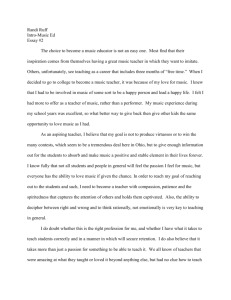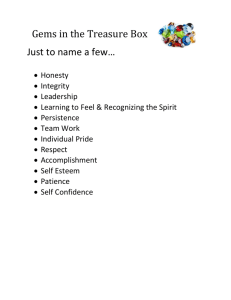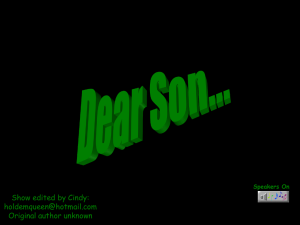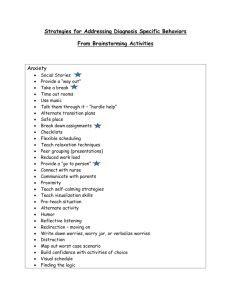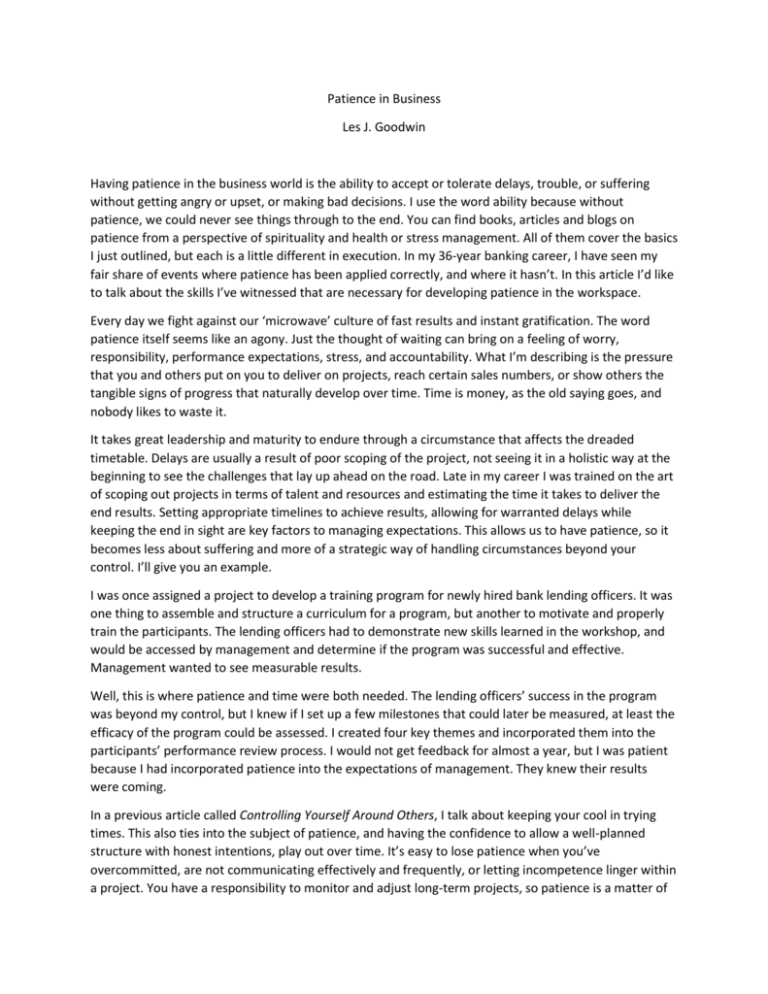
Patience in Business
Les J. Goodwin
Having patience in the business world is the ability to accept or tolerate delays, trouble, or suffering
without getting angry or upset, or making bad decisions. I use the word ability because without
patience, we could never see things through to the end. You can find books, articles and blogs on
patience from a perspective of spirituality and health or stress management. All of them cover the basics
I just outlined, but each is a little different in execution. In my 36-year banking career, I have seen my
fair share of events where patience has been applied correctly, and where it hasn’t. In this article I’d like
to talk about the skills I’ve witnessed that are necessary for developing patience in the workspace.
Every day we fight against our ‘microwave’ culture of fast results and instant gratification. The word
patience itself seems like an agony. Just the thought of waiting can bring on a feeling of worry,
responsibility, performance expectations, stress, and accountability. What I’m describing is the pressure
that you and others put on you to deliver on projects, reach certain sales numbers, or show others the
tangible signs of progress that naturally develop over time. Time is money, as the old saying goes, and
nobody likes to waste it.
It takes great leadership and maturity to endure through a circumstance that affects the dreaded
timetable. Delays are usually a result of poor scoping of the project, not seeing it in a holistic way at the
beginning to see the challenges that lay up ahead on the road. Late in my career I was trained on the art
of scoping out projects in terms of talent and resources and estimating the time it takes to deliver the
end results. Setting appropriate timelines to achieve results, allowing for warranted delays while
keeping the end in sight are key factors to managing expectations. This allows us to have patience, so it
becomes less about suffering and more of a strategic way of handling circumstances beyond your
control. I’ll give you an example.
I was once assigned a project to develop a training program for newly hired bank lending officers. It was
one thing to assemble and structure a curriculum for a program, but another to motivate and properly
train the participants. The lending officers had to demonstrate new skills learned in the workshop, and
would be accessed by management and determine if the program was successful and effective.
Management wanted to see measurable results.
Well, this is where patience and time were both needed. The lending officers’ success in the program
was beyond my control, but I knew if I set up a few milestones that could later be measured, at least the
efficacy of the program could be assessed. I created four key themes and incorporated them into the
participants’ performance review process. I would not get feedback for almost a year, but I was patient
because I had incorporated patience into the expectations of management. They knew their results
were coming.
In a previous article called Controlling Yourself Around Others, I talk about keeping your cool in trying
times. This also ties into the subject of patience, and having the confidence to allow a well-planned
structure with honest intentions, play out over time. It’s easy to lose patience when you’ve
overcommitted, are not communicating effectively and frequently, or letting incompetence linger within
a project. You have a responsibility to monitor and adjust long-term projects, so patience is a matter of
good timing, knowing when to act and not to act—as well as listening to your people, trusting they have
the capabilities to resolve issues, and the foresight to believe in the end results. Delays and changes can
sometimes greatly improve the results. What we do during the delays and setbacks is a test of our
resiliency to overcome obstacles while not losing our perspective. We cannot predicted or control time,
but can use it wisely.
Another much larger test of patience came late in my career when I had to oversee the acquisition of a
specialty market segment department of another bank. We had a similar specialty segment at our bank,
but the acquired department was out of our footprint, more of a mid to lower market national layout
than ours, with a different sales model.
We did the best we could to scope out the process before and during the acquisition, and we planned
long-term goals for the department. It had so many complications—everything from their logo name,
systems, pricing, management, physical location and so on—that the entire scope could not be
completely understood at the beginning. We knew there were a lot of factors outside our direct control,
combined market share and cost efficacies that could materialize and that future interest rates would
rise played heavily into the strategy. It was the vision of how to combine the two departments into one
for long-term success that required good timing and patience.
We faced setbacks, unforeseen changes, personnel issues and customer impact daily. Luckily we had
great talent on both sides and strong customer loyalty. I knew that I needed to instill a vision to effect
unity in the two departments, to create momentum for change. Each time I spoke to management and
staff combined, I focused on rallying the cause, and stressed that it wasn’t easy and the results wouldn’t
be immediate, but that we had the chance to become number one in this segment.
Just as we had gotten back on our feet from the acquisition, our bank seized another opportunity to buy
in this same segment a competitor. The new acquisition would bring in good management, and more
loyal customers, but our new unified structure was already being tested—did we build the structure and
have the talent to grow this fast? We had established enough patience to watch the original plan unfold,
and now we had added uncertainty, delays, and changes to deal with. I still believed we could be
number one in this segment, and I also was certain that the second acquisition would further that cause.
Again, we would just have to be patient.
The question was, how to measure progress while keeping in line with the long-term goal under these
conditions. We built in financial measurement milestones, and exercised good project management. The
key was our clients because they paid our bills and made us profitable and sustainable for the long term.
You never get to keep all of your customers during these types of acquisition events. Not everyone likes
change, and some are just looking for an excuse to leave. The secret was having an aggressive client
acquisition plan to replace the lost customers with new ones and better pricing.
The plan worked and with patience by all, we well exceeded the goals. There was still a lot more to
accomplish, but at least the revenue was there to help us weather any unforeseen delays.
Having the patience to let a plan evolve to an end state is the ability to endure internal and external
pressure. The politics and ego issues that arise during change management events like these can
consume you. It takes a strong backbone, belief in your people, and the ability to make changes when
necessary to exhibit this skill of patience.
Of course it’s easy to look back after a difficult experience and say that with patience all worked out in
the end. It’s during the event that really tests whether or not patience was exhibited. Angry outbursts
and emotional responses during a time of stress translates to stress on all involved. It can suck the life
out of you when you are trying to find a solution to a complication or handle an unexpected delay. In
many of my articles I focus on people skills, caring for others, and developing them to create long term
success. Having patience plays into this overall strategy, and it’s during times of change that people can
be trained, developed, and taught new skills and perspectives.
Here are some thoughts that may help you have more patience in the workplace:
Patience is about time; you do not know the future.
Expectations of fast results can give you less than best results.
People are imperfect, plan on it.
Be realistic more than optimistic.
Communicate that it’s ok to wait.
Have patience with yourself; you do not know everything.
Have patience with others; they do not know everything.
Count on setbacks and delays; no plan is perfect.
Guard your reactions to change.
Monitor people’s expectations; communication is vital.
Monitor the team’s performance and make corrections when needed.
I have been in sales for most of my career. Timing and patience play a big factor when it comes to sales
goals and the expectations for results—it’s all about, when? There is little tolerance or patience in sales.
Sales involve people and that creates a dynamic that isn’t always predictable. Ideally, management and
sales people would like consistent and timely sales, but this is difficult to produce, and patience is
always needed. You can drive your sales organization crazy and actually lower results by being impatient
for results.
Another factor that requires patience is when events on the customer side are driving the sales process
faster or slower than expected. I’ll talk about this more in another article that’s focused entirely on
sales. Also, sometimes an entire organization has to practice patience while new staff is being trained or
a new person is weaved into your structure, it takes time. An adjustment is always needed to evaluate
and correct—thus, patience.
It’s so easy to rush a sale instead of letting it evolve. For instance, right now I’m focusing my business
activities in Asia, where patience is of utmost importance. A lot of times a verbal agreement, with yes
meaning they understand and can now discuss the approval process, is not an actual approval. If you cut
this cycle short because of impatience, without building trust and following cultural protocol needed
before the deal can be closed, you will blow the deal and not be invited back for more business.
What you do while being patient is the key to your future success. Let me give you an example. I was in
a department for fifteen years and wanted to move up to management. My boss kept talking about
retiring, but it went on for five years longer than anyone expected. I had my hand up to be considered
for the position and I was biding my time. During those five years of waiting patiently, I thought that the
natural progress upwards for me was to replace my boss—but it wasn’t. After the five years was over, I
got an even better position that moved me farther along than I had anticipated.
The reason for this was because in those five years I continued to perform at my best level, and I took
the time to develop more management skills and started planning my style to manage. I created a
network to get things done once I was promoted to boss. My focus was on communication,
empowerment, politics, product development, reporting, market segmentation and people
development. (I talk more about having a career development plan in my article Focus on People
Development.) The point here is that I didn’t just sit and wait. I was proactive to be prepared for the
next step in my career. It didn’t matter which direction my job took, I was equipped to be a leader.
During the next ten years after my promotion I simply executed the plan I had worked on for those five
years of preparation.
Patience is more than just enduring or persevering, it’s about the mental and emotional responses to
life’s ups and downs; it’s a state of being aware, but still decisive enough to react to what is being
thrown at you.
Others can tell by your demeanor and your foresight whether or not you are capable of being patient.
Here are some examples of what people should see in you:
A guarded mouth that lifts people and does not lower people.
Body language that invites communicating and does not repel comments.
Understanding of the details without having to dwell in them.
Empowerment of others to resolve issues.
Trust in others to get their jobs done without meddling.
Following up at appropriate and agreed upon points to validate progress.
Being visible and positive to demonstrate a cool and realistic perspective.
The business world has challenges; that is why it’s work. Whether we’re in a corporate structure or
running your own business, we need to be prepared to handle ourselves in all circumstances. All
business leaders and staff need a better understanding of the components of patience. As I stated
earlier, patience isn’t what people want to hear, especially in the midst of a storm, but it is the necessary
perspective you must have if you want to survive.
Content copyright 2015. ISE Advisory Group. All rights reserved
Author: Les J. Goodwin
President/CEO, ISE Advisory Group, Inc. (US)
Managing Director, ISE Asia Advisory Group PTE LTD (Singapore)
In 2014, Goodwin founded consulting firms ISE Advisory Group, Inc. (ISE) and ISE Asia
Advisory Group, Singapore to provide business support and expertise in strategic planning,
project management, human capital assessment, and change management planning.
Mr. Goodwin, has over 36 years’ experience in corporate expansion, mergers and
acquisitions, change management, income/expense management, strategic planning and
execution oversight. He has formed a team of professionals to offer actionable strategies to
improve performance and sustain a lasting financial impact for growth. A key factor in his
success has been in creating solutions for management, owners and investors to make wellinformed decisions to address challenges and takes advantage of opportunities. During his
25 years with MUFG Union Bank, N.A., Mr. Goodwin elevated from relationship management
to serving as Managing Director and Head of the Commercial Treasury Services Division
within Transaction Banking Americas. In this capacity was directly responsible for managing
deposit and treasury services strategy for a variety of segments including corporations,
middle market, business banking, non-profit businesses, real estate developers/investors,
REIT management companies, and commercial/residential property management
companies. In 1987, Goodwin was appointed Acting President and Chief Executive Officer
by the FDIC to manage daily operations and minimize loss exposure for a troubled financial
institution. As a result of his involvement with the FDIC, Goodwin was hired in 1989 by
Shearson Lehman Hutton as a Financial Consultant and Regional Institutional Sales to
develop and structure securitization transactions for financial institutions in the Western
region. Goodwin has served on several committees and held board positions for the Los
Angeles County Economic Development Corporation (LAEDC) and other associations,
including California Bankers Association and Western Independent Bankers Association.
Goodwin currently lives in Simi Valley and has an office in Los Angeles.

